The search for keywords should be the basis of your SEO strategy, if you are not clear by what words users come to your website, it will be very difficult (if not impossible) to increase and optimize traffic.
Take keyword research as the market research of the 21st century. They help you figure out the thoughts, fear, and desires of your target market, so you know how and where do users search for content.
The goal once all these keywords are found is to incorporate them naturally on your page to achieve greater visibility in search engine listings.
What is Keyword Research?
Keywords are words or sets of words that are used to match content with our search for information in a search engine.
Basically, search engines base the relevance of a page for each search, depending on the keyword, and how many times that word or phrase appears within the web page, among other techniques.
Therefore, the keywords are the base of the content of our website. Without keywords, no only that we cannot produce relevant and attractive content but users cannot find your pages to begin with.
So it’s important to know how to find the most beneficial ones and know how to use them in your SEO On-Page and Off-Page

How do Keywords Performance Boost Your Traffic?
To position your content on the top of search engine result pages and increasing your traffic, it’s essential to carry good SEO techniques.
Knowing how to search for keywords to improve your SEO is crucial, so it is knowing which tools will help you find better keywords for your company.
The selection of the right keywords is fundamental when planning your online strategies. When you start using the appropriate keywords:
- your site views will increase,
- your positioning improves,
- you’ll have more tools to concern your audience,
- generate more interaction,
- gain more relevancy.
The result of a job well done!
6 Steps to the Ultimate Keywords Research
1. Make a keyword research
To carry out good Keyword Research, we need to start by making an initial list of keywords that are relevant to your business and audience and could attract potential customers for conversion.
It is important you define the topics you are going to address. The definition of your topic will help find the right keywords so they can adapt better to your product and services, hence, to your content.
The first thing you need to do is create a keywords list that is in accordance with your business. You need to make sure you know what you are offering, who are you offering it to, where are you offering it, and what makes you be different from your competitors.
- What’s the center of your business
- What are your selling
- Which services are you offering
- What’s the profile of your client
- Online or physic location
Now you know where you are headed and who is following you along the way, create a spreadsheet in which you’ll be adding the keywords from now on. Divide the columns in:
- Keyword
- Volume of search
- Competition
- Word difficulty
- Notes

To find the keywords that will boost your company and attract users, you can count on different sites that will give you the information you need to complete your spreadsheet.
In the next step, we’ll see how to analyze the difficulty of keyword positioning, and use the right tools to find keywords.
2. Analyze the positioning difficulty of each term
A common mistake is trying to rank on terms with high search volume, irrelevant for your business, and highly competitive, instead of choosing words that are more specific, relevant, and less competitive.
So, not only that you fail to will increase your page views, but Google is also going to downrank you for not being relevant.
Moreover, the higher the volume of searches, the more difficult it is to position, not taking into account that there are so many other elements that influence the positioning.
But also, keywords with the highest volume usually need more time to position in the rankings. It has its logic, the higher the volume, the more results that search tends to throw against those you have to compete against.
To analyze the competitiveness of each term and see how those are working in SEO levels for the competitors, we can use specific tools such as SEMRush or MOZ, to see a list of keywords and determine the difficulty level of each term we want to position.
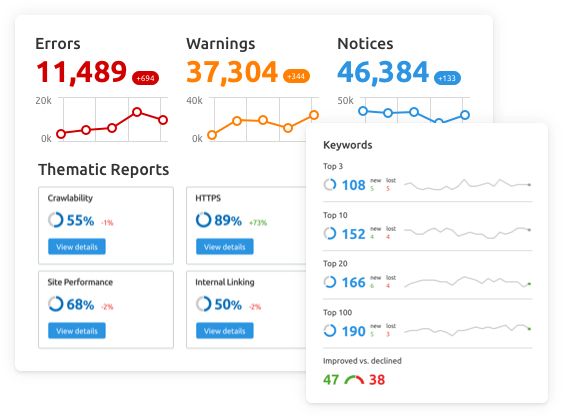
If we want to do it for free, we can enter the terms in the Google search engine and analyze the results that are positioned on the first page of Google results.
Make a research of each page, analyze how they are optimizing the pages; how many inbound links point to those pages, the domain and page authority of those results, the social media shares, and the age of the domain.
3. Keep an eye on the search volume.
First of all, think of all the possible ways to express the concept or concepts represented by the web that we are going to position in the form of a keyword.
Look for synonyms and ways to express it, alter the order of their words, among others.
For a correct implementation of this process, we will use Google Insights For Search (we’ll touch on that on the next point) to see the volumes of visits for these keywords, their seasonality, and see which derived keywords the tool recommends us.
This process will allow eliminating a few keywords from our list. To measure the results of the keywords, It is also important to take into account three values:
- Seasonality: The keyword alters your results at different times or, is it responding to news and events?
- Location: Is it searched in a specific country or region, or is it a global keyword?
- Language: Are we going to position the keyword in a particular language or is it universal?
Taking this into account, we can apply these same areas to our customer’s behavior; Is it a one-time search for a specific date and season, where were they at the time of the interaction with the webpage, and in which language did they find us.
Moreover, search volume differentiates keywords according to the number of searches around them, it is divided into three groups:
- Head: They are very broad searches with a lot of search volume and a lot of competition.
- Middle-Tail: More specified searches, but still general.
- Long-Tail: They are very specific searches, with little competition and mostly transactional.
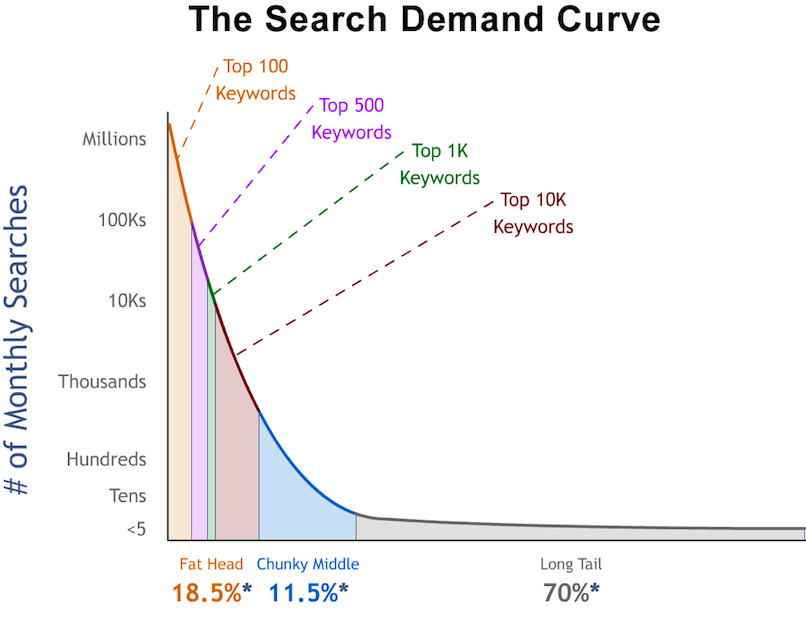
It is important you focus on your Long-Tail, as is more than 70% of the visits that enter your website, so even if you are managing to position your determined keywords, you can not leave out the long tail.
What’s more, the traffic that comes to you through generic words has a worse conversion than long-tail ones.
A great way strategy to position you Long-Tail, and maybe your competitors are not worrying about, is Voice Search, as it helps you increase your search engine optimization.
When we’re using Voice Search to find answers on the Internet we tend to make complete questions, hence question keywords could be a great way to optimize your search.
4. Search for Trends
You may find two terms that have the same search volume. So, which one should you choose? Study the trend of the terms with Google Trends, see if their popularity is increasing or descending over time.
Prioritize terms that have a positive trend. It is a winning bet that will generate more volume in the future.
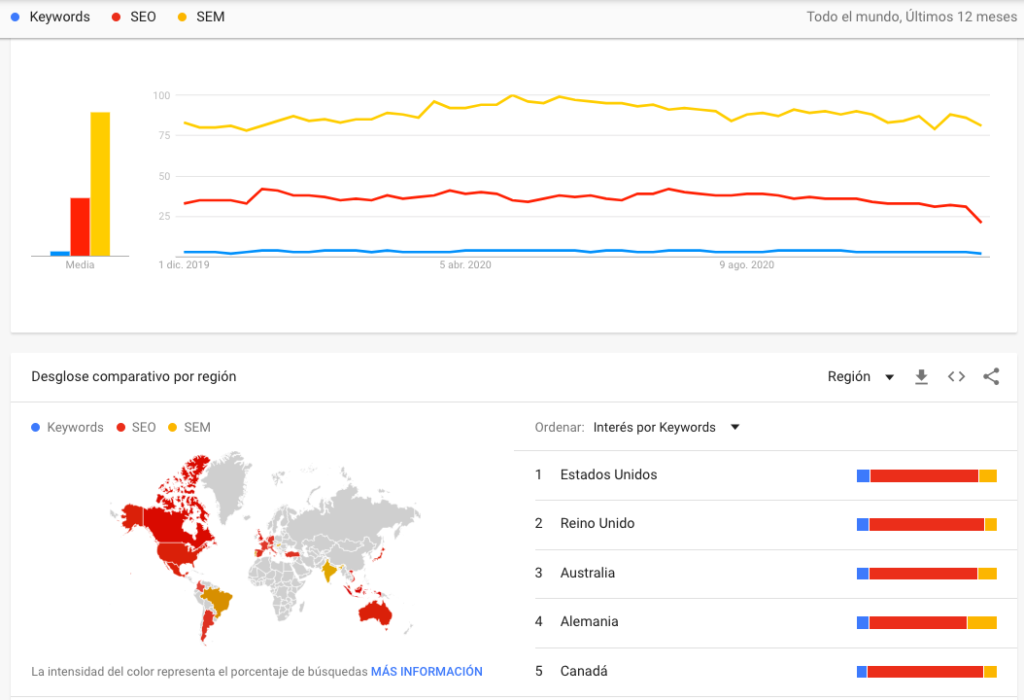
Google Trends is a very intuitive and easy-to-use tool. You can view trends worldwide or you can filter by search terms, related category, a period of time, or by the medium, that is, if the medium used has been Google, Youtube, Bing, or any other.
It becomes an ally to analyze the interests of our potential clients and the seasonality of searches. Based on the results obtained, we can establish different strategies around our business.
Using both tools will help you choose the right keyword with high search volume, as well as changing some in past entries, this way you can replace the ones that are not generating many benefits for others that are more current and in trend.
5. Pay attention to your competition
Take into account that just because a keyword is important to your competitor doesn’t mean it is important to your website. However, understanding the words your competitors are trying to rank for is a great way to help boost your own list.
But, which competitors are worth following? To know the authority of each domain, and see with which keywords are they raking in search engines, there’s a great tool to keep an eye on your competitors, the MozBar Chrome extension.
If your competition’s websites are very well positioned, it will be very difficult to compete with them. There are tools like Moz Keyword or SEMrush that offer metrics to measure the level of difficulty for a certain keyword.
Study all the factors well to create a strategy that allows you to compete.
- Google Adwords’ Keyword Planner: is the first and obvious option, and it’s free! Adwords is useful for investigating the keywords related to our website and our industry, showing us which ones have the greatest amount of search so that we can select the most appropriate terms to include in our content. It also estimates offers for each suggested keyword, so that we can plan the advertising budget.
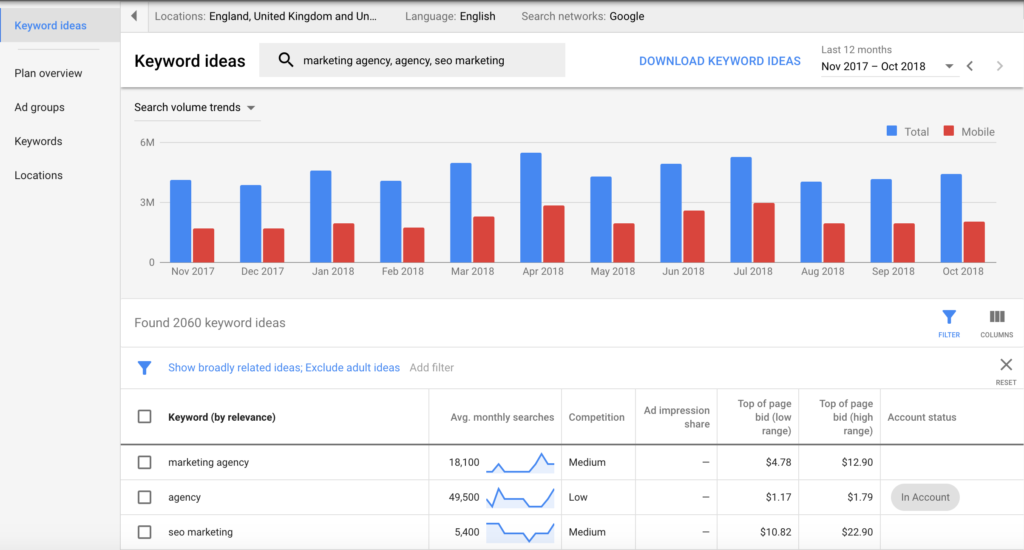
- SEMRush: It is one of the most complete tools. It has a limited free version, but it very helpful for an initial search, especially to discover what the competition’s keywords are. Then they offer a much more complete paid version, which allows you to do unlimited searches, delve into the SEO and SEM of the competition, and even provides content suggestions to achieve better positioning.
- Moz Keyword: Moz has several SEO tools and in its free version it has some important functionalities covered, but doesn’t offer monthly search queries (only ranges, as in Google Planner). However, it has a Keyword Suggestion. This functionality has different variants, including a filter called “Based on broadly related topic and synonyms”, that provides a list of keywords with search volume and related to our central theme.
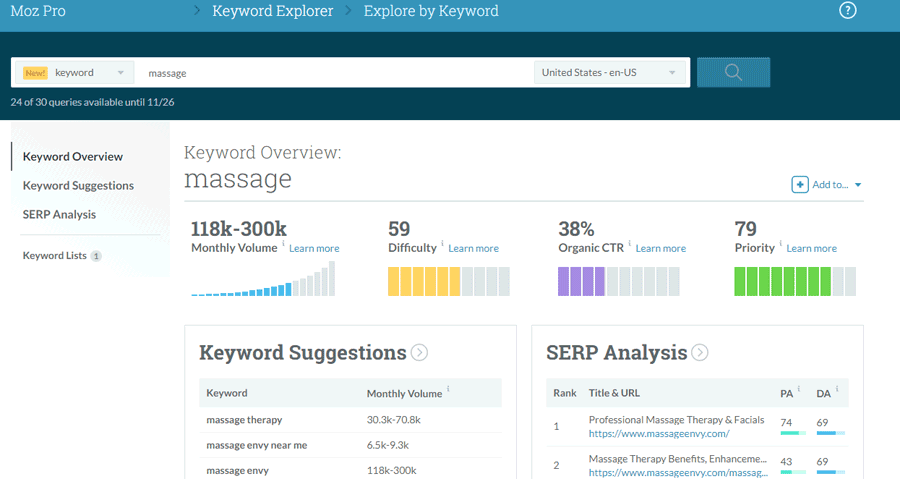
- Ubersuggest: This tool can give you additional keywords to those found in the Keyword Planner. It is very easy to use, and it gives you useful information to choose the keywords with the greatest impact. It also identifies the source of traffic for these searches (SEO or SEM), the age range of those who search, and provides ideas for other keywords and existing content related to the topic.
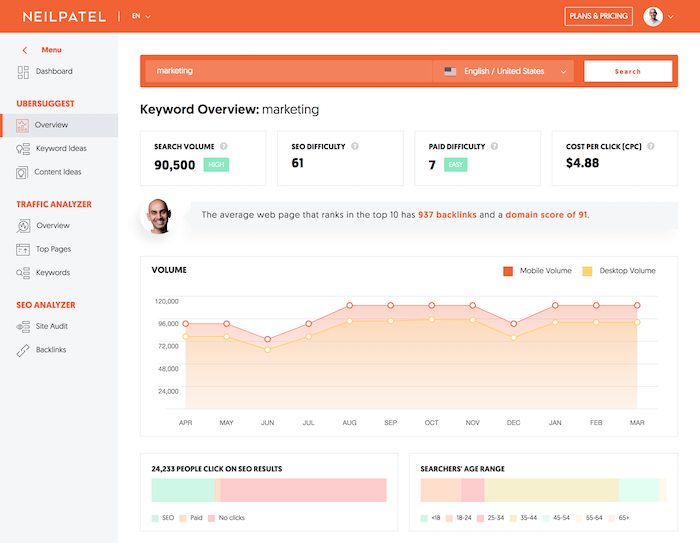
Competitors can also be helpful. The backlinks profiles have a big influence on the search engine rankings in Google.
Analyzing the backlinks of your competitors will help you find new trusted sources and create a content plan. Look and ask for Link Building so you can increase your community and traffic.
6. Target your niche
When selecting keywords to target our SEO campaign, we must think about our Buyer Persona. It’s crucial when we’re just getting started.
Because keyword research can be daunting at times, especially if we see our competitors ranking high for a specific term or words.
Therefore, we must find the right keywords to address our target audience. As we develop our SEO strategy and begin to position ourselves in search rankings, we can boost traffic, by using specific long-tail keywords and put ourselves in our Buyer Persona’s shoes.
Regarding our targeted audience, it’s important to stay relevant to them at all costs. A great way of doing that is by matching content with customer intent via zero-click search.
- Keywords can be easily linked to content on your site as part of content creation to reflect your potential customer’s intent without knowing exactly what it is. It’s as simple as analyzing what the customers are searching for on Google and what they are asking on social networks. This data will form your keyword cloud and can then be linked to what you offer.
- While doing keyword analysis, you can focus on three main intention types and purposes of the search queries; Commercial and Highly Convergent Phrases, Informational Word Groups, and Operational Word Groups
- Incorporate keyword analysis into Intent Marketing. When you’re trying to understand customers’ search queries, you have to pay attention to automatic word suggestions in Google search queries, search queries on the search box of your e-commerce site, search queries, and automatic suggestion options in virtual marketplaces and Google’s location-oriented search query suggestions.
To match our content with customers it’s important to know which are their intentions, why are they searching for a specific word in a specific time and place.
It depends on one’s motivation and purpose of the search, the keywords typology are categorized in the following:
- Navigation searches: when people make a query with the sole purpose of finding a specific. Naturally, the best-ranked websites show in the first results.
- Information searches: These keywords refer to specific information, tips, or guidelines where the user is trying to learn something new. Information searches often take the form of a question so it gets the desired answer faster.
- Commercial Investigation: These searches are somewhere between informational and transactional. These searches are often associated with superlatives and comparative words.
- Transactional searches: The primary goal of these searches is a transaction. However, it does not have to be in the form of a purchase, it can also be a registration, download, or any other similar action. A transactional search allows you to seek through different e-shops and retailers with the outcome of paying the least amount.
Conclusion
Keywords play a major part in the success of your SEO strategy, it’s important to dedicate time to research the right keywords for your business, so your traffic can increase and boost your popularity in the search engines.
It’s a long process, but effective, it’s not all about writing a good article or developing a great webpage, but all those previous steps of research and preparation before writing the first word of your article or post. By following these steps you will also generate more organic traffic and successfully position your website.

Comments are closed.